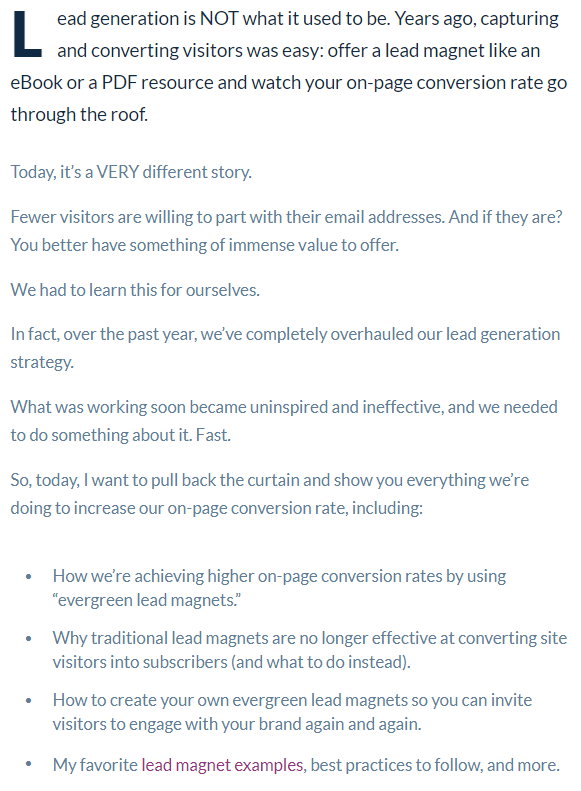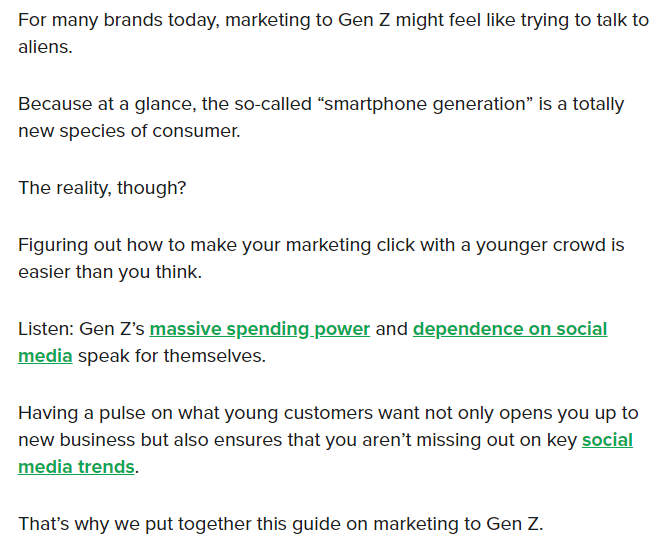
“Oh boy, I can’t wait to read this 3,000-word feature breakdown post!”
Said nobody ever.
Just kidding. I mean, some of us are totally stoked to read (and write!) about SaaS.
But unless your audience is working in SaaS themselves, getting people excited about software is often an uphill battle.
This is especially true when it comes to blog posts.
Whereas videos and infographics are entertaining and easy to digest, SaaS blog writing needs to be carefully tailored to hold a reader’s attention from sentence to sentence.
So, how do you make sure your posts aren’t putting readers to sleep?
5 SaaS blog writing strategies to snooze-proof your posts
Conventional wisdom tells us that SaaS blogging has to be boring.
I disagree. Most other SaaS bloggers probably would, too.
Don’t take my word for it, though.
Below are some excellent SaaS blog examples and key takeaways for bloggers looking to make their own posts more compelling.
1. Focus on solving meaningful, real-world problems
First thing’s first: make sure you’re writing posts that people actually want to read.
Not fluff. Not fodder for search engines, either.
One of the best ways to ensure that you’re writing meaningful content is through effective research.
For example, what sorts of questions are folks asking on Twitter or LinkedIn? Instead of speculation, look at actual conversations your audience is having about your solution or industry.
The same logic applies to keyword research.
When looking at keywords, keep an eye on relevant “how-to” queries and their search intent (think: “how to retain more customers”).
This post from Copper is a great example of SaaS blog writing that addresses a specific pain point and offers up a variety of actionable solutions.

From the introduction alone, readers can immediately relate to the frustrations of being unable to focus at work.
Structurally, each subheader presents a specific solution that addresses the problem at hand. This includes Copper’s own suite of tools in addition to free tools within G-Suite.
Coupled with tons of screenshots and examples of how to put these tips in action, this post is clearly more than just fluff. It’s well-researched and speaks to its title pain point.

Here’s another great example of effective SaaS blog writing from Groove.

Again, this post speaks to a very specific problem (hint: the challenges of providing good customer service).
Through interviews with actual customer experience experts, the reader gains meaningful insight from the real world. First-hand experiences mean much more to readers than vague, speculative “tips” from folks who haven’t actually been in the field.

The breakdowns and tips in this post aren’t strictly product-related, but that’s because SaaS blog writing isn’t all about the hard sell.
Ideally, top-of-the-funnel content should be about education and problem-solving while your product serves as the next logical step for readers as they learn more.
This gives you an opportunity to sell your personality and actually hook your readers rather than bore them to death.
2. Fill your posts with imagery (graphs, charts, screenshots)
As a rule of thumb, I try to make my posts as scroll-friendly as possible.
Some bloggers suggest inserting an image or embed every 100 words to break up your content. Others recommend 300 words.
Either way, image-heavy posts typically perform well in my experience.
The beauty of SaaS content is that are tons of opportunities to sprinkle imagery throughout your posts.
Product screenshots. Graphs and visualizations of data. Infographics.
The list goes on and on.
And hey, research from Venngage indicates that these sorts of embeds are among the top-performing types of visual content for bloggers.
As noted earlier, infographics and videos are used to either supplement or complement blog writing due to their inherent shareability and entertainment value.
But by frequently including images within your posts, you can create the same sort of “must-see” effect via blogging.
Let’s look at this case study post from Databox as a prime example.

This post is brimming with graphs, first-hand data and specific information to help highlight the “how” and “what worked” of Databox’s case study.
The positive results noted in the post’s title (75% more traffic in six months) is driven home by growth illustrated in various charts and graphs. This naturally makes the reader want to keep scrolling and see “what’s next” to emulate similar results themselves.

This post also circles back to tip #1 of speaking to a meaningful problem. That is, increasing blog traffic and making the most of old blog posts which may have stagnated.
Here’s another great example of image-heavy SaaS blog writing from SEMrush.

In this particular post, the imagery is the star of the show (particularly the post’s promised checklist infographic).
Coupled with that infographic is an embedded and bite-sized breakdowns of how to put these on-page SEO tips into action.

Both scannable and actionable, this post is anything but boring.
3. Reel in readers with your headline and premise
It’s no secret that headlines are make-or-break when it comes to grabbing someone’s attention.
Introductions are pretty damn important, too.
In fact, a recent survey from Growth Badger notes that top bloggers cite headlines and introductions as the second only to “quality content” when it comes to what makes a compelling blog post.
In short, your blog posts need a strong hook. This might mean asking a bold question or requiring readers to challenge their beliefs.
Note that most posts get shared around social media based on their headline alone. The key isn’t to resort to clickbait, but rather present a premise that grabs your reader.
This post from Sleeknote highlights how SaaS blog writing can pique the curiosity of readers by posing a bold question.

The post’s premise requires the reader to rethink conventional wisdom.
“Are lead magnets dead? I don’t know. Better read more.”
Based on the title and introduction alone, readers naturally want to move through the post to satisfy their curiosity.

The statistics, examples and data presented in the post don’t disappoint and serve to educate the reader every step of the way. No clickbait here.
Here’s another example of a great blog post premise from Help Scout.

The post itself is friendly to searchers looking for a definition of what a support ticket is.
However, the second half of the headline compels the reader to want to learn more beyond a basic definition.
“Okay, why don’t you use support tickets? I thought everybody used them.”
The post’s premise immediately helps the post stand out among competing content and challenges the status quo in the process. This allows Help Scout to position themselves and likewise highlight their values (think: not objectifying people into data, etc).

4. Don’t be afraid to get to the point
Perhaps the simplest way to keep people from snoozing on your SaaS blog posts is by getting to the point.
Translation? Write shorter posts.
Of course, this goes against typical recommendations in terms of the “ideal” blog post length for SEO and readability.
Most SaaS blog writing is long-form (think: 1,500 – 2,000+ words) these days.
That said, there’s still value in shorter reads. Writers can also “chunk” their posts with frequent subheaders that manage to target keywords and answer brief questions for readers without overwhelming them.
Let’s look at a blog post from Trello that does exactly that.

Formatting is key here. Frequent subheaders throughout the post manage to break up highlight multiple questions and answers, making the post direct and likewise scroll-friendly.
Scanning each subheader, I can get exactly what I need without wasting time.

Meanwhile, SaaS giants such as Monday.com publish content of varying lengths, denoted by their read-times (“5 minutes,” “3 minutes” and so on).
This sets an expectation for readers and lets them know whether or not a post is in-depth or something they can scroll through on the train.

Reality check: not all SaaS blog posts need to be thousands of words.
If you can say what you need to say while targeting a keyword or addressing a pain point in a few hundred words, go for it.

5. Keep your posts conversational
Finally, finding the right tone is one of the biggest parts of being a SaaS writer.
It might be cliche but you’re writing for humans.
And yeah, if you’re writing for SEO you’re kind of writing for robots, too.
Either way, don’t ignore the elements of style and tone. Simplifying your language and injecting some personality into your posts is key to making your SaaS blog writing less boring.
Here’s a post from Later that manages to do both.

Guidelines and regulations are perhaps some of the most boring topics to cover.
However, this post manages to break down its points minus any jargon. Subtle style choices such as referring to the reader as “you” and including frequent paragraph breaks also make this post easy to read.

To wrap things up, let’s look at one of my recent posts for Sprout Social as another example.

For this particular post, I had to be self-aware about the fact that I was writing about teenagers and twentysomethings.
Rather than come across as out-of-touch, I opened with a bit of humor and tried to maintain a conversational tone throughout my introduction.

See how that works?
Despite popular belief, writing about software doesn’t require you to be totally “suit and tie.” A bit of personality can go a long way toward retaining readers.
What does must-read SaaS blog writing look like to you?
The main takeaway from all of this is that SaaS blog posts don’t have to be boring or stuffy.
From style choices to problem-solving and beyond, snooze-proofing your posts can be done regardless of your product or industry.
And given the benefits of blogging for SaaS, the need for well-crafted posts isn’t going away anytime soon.
Any other thoughts on what makes a “good” SaaS blog post? Which companies are putting out the sort of content that you eat up? Let me know in the comments below or hit me up on Twitter (@brentwrites).
This post was last updated on 1/22/2020.
As a marketing analyst and wannabe blogger I found this post to be extremely insightful. Particularly as I am trying to refine my writing